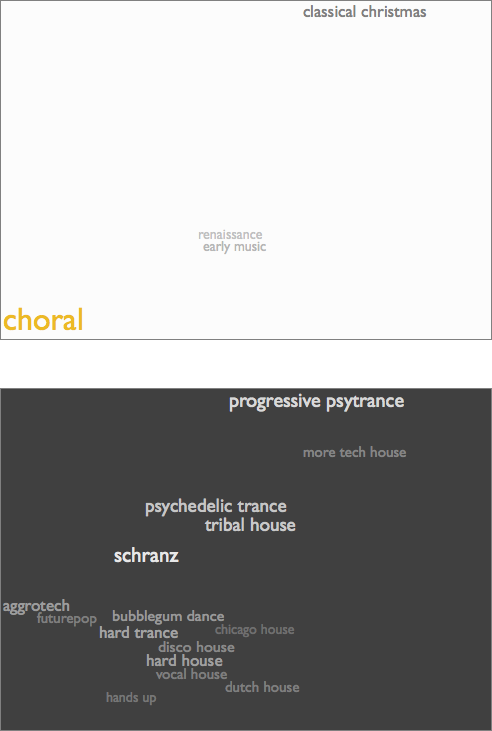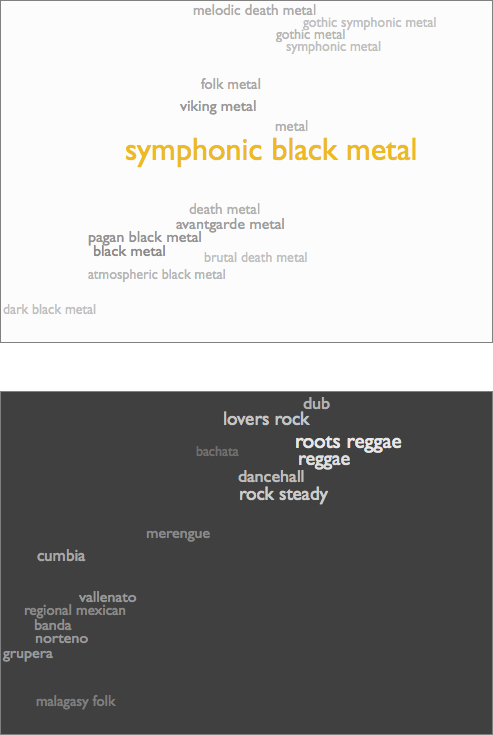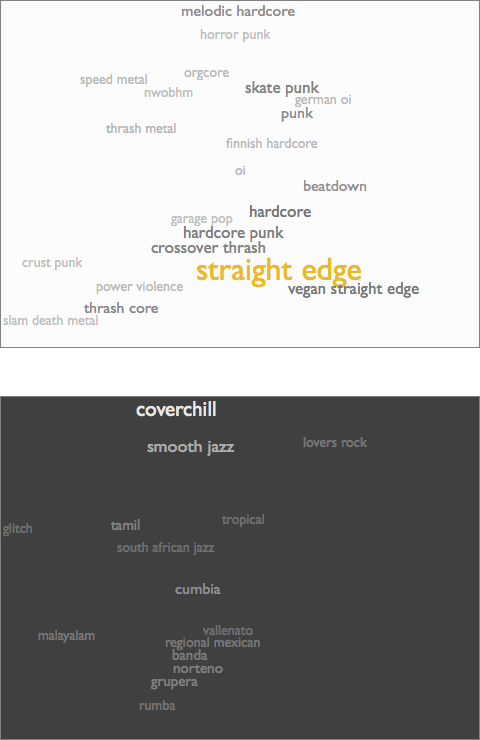¶ The Opposite of Love Is Love · 16 November 2013 listen/tech
The data and math behind Every Noise at Once allow me to calculate audio similarity between genres, which is pretty obviously cool and useful. The distance scores can be sorted the other way, too, to produce dissimilarity. This works, in the sense that the program doesn't crash before producing results (my first level of quality in computational aesthetics), but it turns out that the farthest genre from pretty much anything is always one of a handful of extreme outliers: choral music, poetry readings, relentless tech house, satanic black metal. This sort of makes sense (my second level of quality), but it isn't very interesting or useful (level three).
It recently occurred to me to try it a different way. Instead of calculating the furthest genre, I instead take each genre's position in the 12-dimensional analytical space, invert it through the origin of the space, and find the genres closest to that inverted point.
Which sounds delightfully abstruse. "12-dimensional analytical space"! But it just means that I'm trying to produce a computable notion of genre opposition that finds some kind of music that is approximately as conventional or extreme as the genre you started with, but in which every individual aspect we can measure has the opposite polarity. So if we have a genre that's a lot faster and slightly louder and somewhat more electric than the average, I look for a genre that's correspondingly a lot slower and slightly quieter and somewhat more acoustic than the average. Except there are 12 metrics, not just 3, which is hard to picture as a space, but no harder to calculate.
This version also doesn't crash, by which I mean that it crashed a little, of course, until I got the right number of "i"s into all the uses of "audiocentricity", and stopped overwriting function declarations with variables (ah, Python...), but now it doesn't, so that's level one.
There's some subjectivity to the question of whether anything under the heading of "opposite of a genre" makes sense. But when I measure that audiocentricity, or how close things are to the theoretical center of the imaginary space, the highest scoring genres include such definitively mild forms as mellow gold, jam band and soft rock, and the lowest scores go to the most recognizably extreme forms (culminating, again, in choral music). And the opposite of choral music turns out to be schranz, and the opposite of symphonic black metal is roots reggae, and the opposite of straight edge is anonymous bossa nova covers of Sting songs. Which feels like it's onto something. So I'm going to call that good enough for level two.
To help find out whether these opposites are interesting or useful, I've added them to my maps. At the bottom of each individual genre page, where there was already a little inset map of the genre's musical neighbors, there's now also an inverted nightside view of the area of the genre's opposites. E.g. this pair for choral music:

In the nearby map you see that there's very little very close to choral music, but tunnel through the center to the other side of the musical universe and you emerge in a glittering midnight riot of relentless motion. Choral music is cool. But manic psytrance is also cool.
Here are symphonic black metal and straight edge:
I'd long believed that I simply can't stand anything resembling reggae, but in fact I turn out to like dancehall a lot. And bachata and vallenato are fabulous, and malagasy folk is kind of like a piece of Africa snapped off and went Caribbean. On the other side, "coverchill" is kind of a grimly fascinating convocation of horribleness, but for me glitch is anti-pop comfort music, and Malayalam is not only a trove of Indian pop, but also the only major human language whose name is a palindrome. And the fact that that little cluster of regional Mexican styles is in some sense the opposite of both symphonic black metal and straight edge is a valuable reminder about the subjective nature of even the magnitudes of distinctions.
But of course the opposite of anything is amazing. The opposite of love is still love. Even the idea of opposition is essentially love undergoing introspection. If you tire, for just a moment, of whatever you already adore, all you have to do is try to look inside yourself and overshoot, and there you are amidst a dozen definitively different things gleefully swarming to enthrall you.
[PS: Level four is to discover something we didn't exactly know yet. Level five is to discover how to measure something we didn't know how to know.]
It recently occurred to me to try it a different way. Instead of calculating the furthest genre, I instead take each genre's position in the 12-dimensional analytical space, invert it through the origin of the space, and find the genres closest to that inverted point.
Which sounds delightfully abstruse. "12-dimensional analytical space"! But it just means that I'm trying to produce a computable notion of genre opposition that finds some kind of music that is approximately as conventional or extreme as the genre you started with, but in which every individual aspect we can measure has the opposite polarity. So if we have a genre that's a lot faster and slightly louder and somewhat more electric than the average, I look for a genre that's correspondingly a lot slower and slightly quieter and somewhat more acoustic than the average. Except there are 12 metrics, not just 3, which is hard to picture as a space, but no harder to calculate.
This version also doesn't crash, by which I mean that it crashed a little, of course, until I got the right number of "i"s into all the uses of "audiocentricity", and stopped overwriting function declarations with variables (ah, Python...), but now it doesn't, so that's level one.
There's some subjectivity to the question of whether anything under the heading of "opposite of a genre" makes sense. But when I measure that audiocentricity, or how close things are to the theoretical center of the imaginary space, the highest scoring genres include such definitively mild forms as mellow gold, jam band and soft rock, and the lowest scores go to the most recognizably extreme forms (culminating, again, in choral music). And the opposite of choral music turns out to be schranz, and the opposite of symphonic black metal is roots reggae, and the opposite of straight edge is anonymous bossa nova covers of Sting songs. Which feels like it's onto something. So I'm going to call that good enough for level two.
To help find out whether these opposites are interesting or useful, I've added them to my maps. At the bottom of each individual genre page, where there was already a little inset map of the genre's musical neighbors, there's now also an inverted nightside view of the area of the genre's opposites. E.g. this pair for choral music:

In the nearby map you see that there's very little very close to choral music, but tunnel through the center to the other side of the musical universe and you emerge in a glittering midnight riot of relentless motion. Choral music is cool. But manic psytrance is also cool.
Here are symphonic black metal and straight edge:
I'd long believed that I simply can't stand anything resembling reggae, but in fact I turn out to like dancehall a lot. And bachata and vallenato are fabulous, and malagasy folk is kind of like a piece of Africa snapped off and went Caribbean. On the other side, "coverchill" is kind of a grimly fascinating convocation of horribleness, but for me glitch is anti-pop comfort music, and Malayalam is not only a trove of Indian pop, but also the only major human language whose name is a palindrome. And the fact that that little cluster of regional Mexican styles is in some sense the opposite of both symphonic black metal and straight edge is a valuable reminder about the subjective nature of even the magnitudes of distinctions.
But of course the opposite of anything is amazing. The opposite of love is still love. Even the idea of opposition is essentially love undergoing introspection. If you tire, for just a moment, of whatever you already adore, all you have to do is try to look inside yourself and overshoot, and there you are amidst a dozen definitively different things gleefully swarming to enthrall you.
[PS: Level four is to discover something we didn't exactly know yet. Level five is to discover how to measure something we didn't know how to know.]


